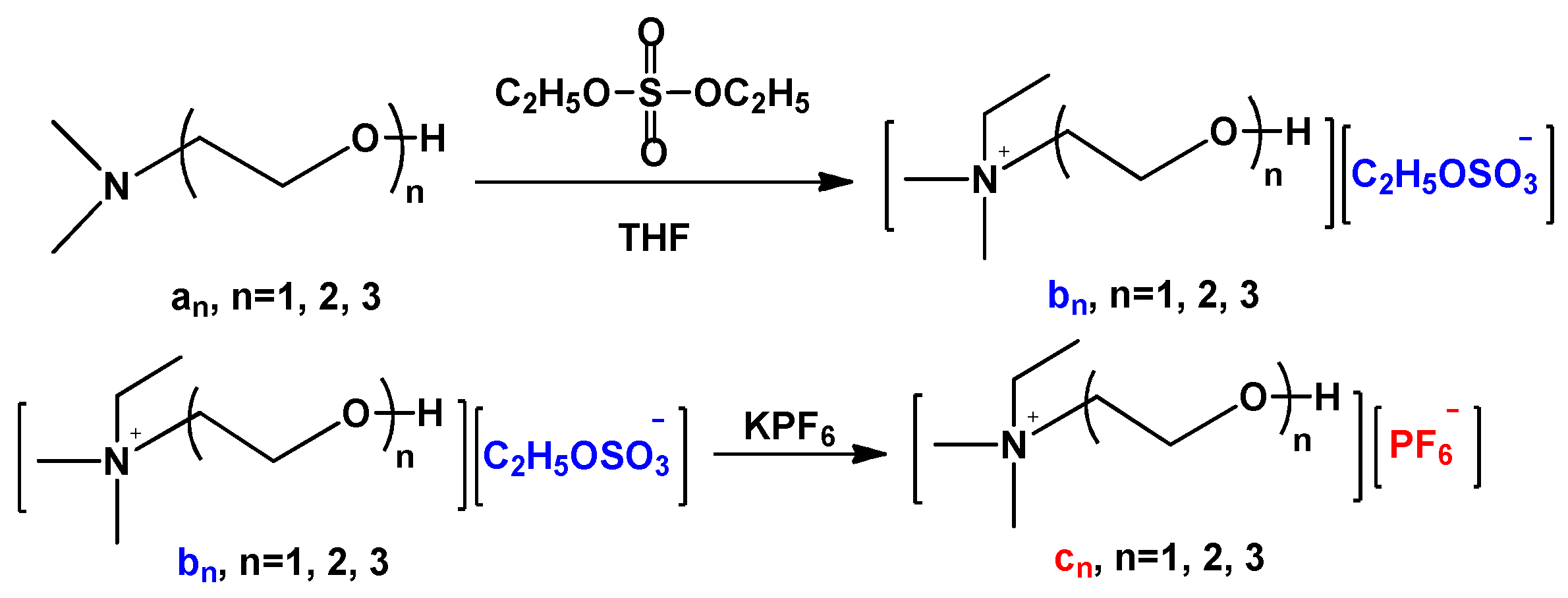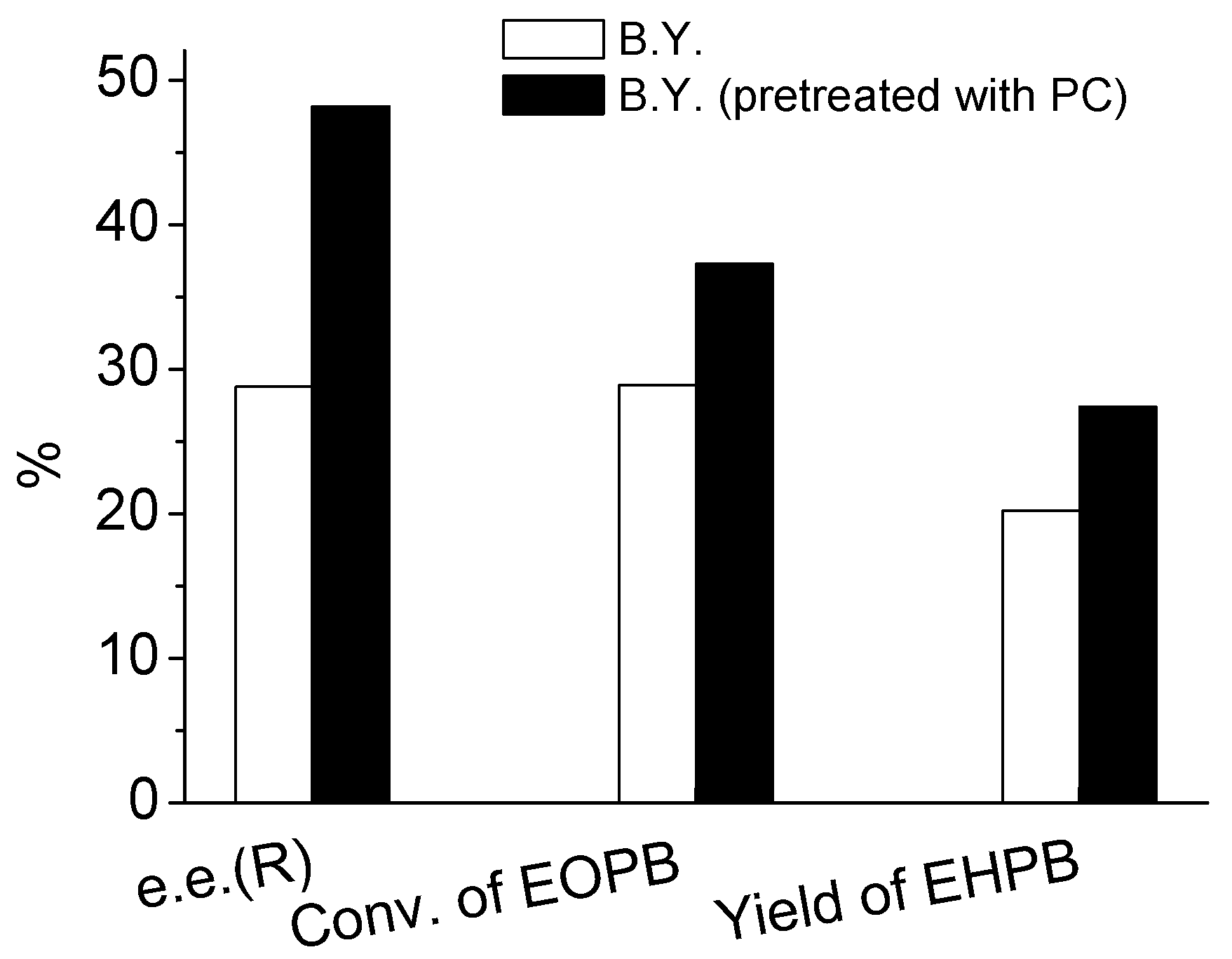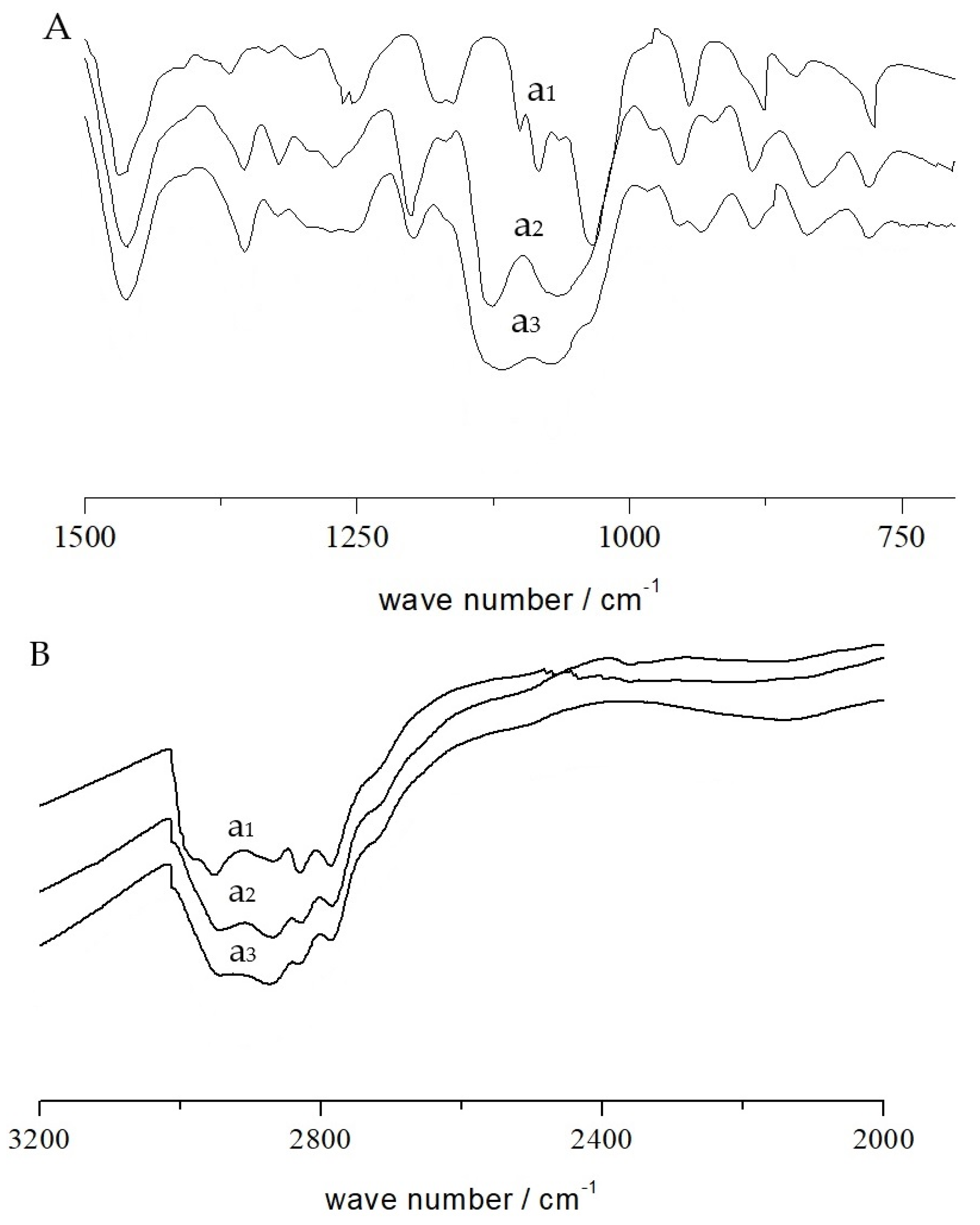Coupling of Bioreaction and Separation via Novel Thermosensitive Ionic Liquids Applied in the Baker’s Yeast-Catalyzed Reduction of Ethyl 2-oxo-4-phenylbutyrate
Abstract
1. Introduction
2. Results and Discussion
2.1. Solubilities of the Ionic Liquids (ILs)
2.2. Phase Transformation Temperature of c2/1,2-Dimethoxyethane Biphasic Systems
2.3. Asymmetric Reduction of Ethyl 2-oxo-4-phenylbutyrate (EOPB) in Thermosensitive Ionic Liquids–Solvent Biphasic System (TIBS)
3. Materials and Methods
3.1. Materials
3.2. Preparation of the Ionic Liquid Precursors (a2–a4)
3.3. Preparation of the Ionic Liquid (b1~b3, c1~c3)
3.4. Bioreduction
3.5. The Pretreatment of Baker’s Yeast with Alpha-Phenacyl Chloride
3.6. Statistical Analysis
4. Conclusions
Author Contributions
Funding
Conflicts of Interest
Abbreviation
| [BMIM] [PF6] | 1-butyl-3-methylimidazolium hexafluorophosphate |
| DMEA | N, N-dimethylethanolamine |
| EHPB | ethyl 2-hydroxy-4-phenylbutyrate |
| e.e. (R) | enantiomeric excesses of ethyl (R)-2-hydroxy-4-phenylbutyrate |
| (R)-EHPB | ethyl (R)-2-hydroxy-4-phenylbutyrate |
| EO | ethylene oxide |
| EOPB | ethyl 2-oxo-4-phenylbutyrate |
| ESI-MS | electron spray ionization mass spectrometry |
| FT-IR | Fourier transform infrared spectroscopy |
| GC | gas chromatography |
| 1H-NMR | proton nuclear magnetic resonance |
| IL | ionic liquid |
| ILs | ionic liquids |
| PC | alpha-phenacyl chloride |
| PEO | polyethylene oxide |
| PTT | phase transformation temperature |
| RSCP | reaction-separation coupling process |
| THF | tetrahydrofuran |
| TIBS | thermosensitive ionic liquids–solvent biphasic system |
References
- Karakatsani, E.K.; Economou, I.G.; Kroon, M.C.; Bermejo, M.D.; Peters, C.J.; Witkamp, G.J. Equation of state modeling of the phase equilibria of ionic liquid mixtures at low and high pressure. Phys. Chem. Chem. Phys. 2008, 10, 6160–6168. [Google Scholar] [CrossRef]
- Montolio-Rodriguez, D.; Linke, D.; Linke, P. Systematic identification of optimal process designs for the production of acetic acid via ethane oxidation. Chem. Eng. Sci. 2007, 62, 5602–5608. [Google Scholar] [CrossRef]
- Lin, Y.D.; Chen, J.H.; Cheng, J.K.; Huang, H.P.; Yu, C.C. Process alternatives for methyl acetate conversion using reactive distillation. 1. hydrolysis. Chem. Eng. Sci. 2008, 63, 1668–1682. [Google Scholar] [CrossRef]
- Bernal, M.P.; Coronas, J.; Menéndez, M.; Santamaría, J. Coupling of reaction and separation at the microscopic level: Esterification processes in a h-zsm-5 membrane reactor. Chem. Eng. Sci. 2002, 73, 1557–1562. [Google Scholar] [CrossRef]
- Irusta, S.; Pina, M.P.; Menéndez, M.; Santamaría, J. Development and application of perovskite-based catalytic membrane reactors. Catal. Lett. 1998, 54, 69–78. [Google Scholar] [CrossRef]
- Kraai, G.N.; Schuur, B.; Zwol, F.V.; van de Bovenkamp, H.H.; Heeres, H.J. Novel highly integrated biodiesel production technology in a centrifugal contactor separator device. Biochem. Eng. J. 2009, 154, 384–389. [Google Scholar] [CrossRef]
- Maria, P.D. “Nonsolvent” applications of ionic liqulids in biotransformations and organocatalysis. Angew. Chem. Int. Ed. 2008, 47, 6960–6968. [Google Scholar] [CrossRef]
- Garcia, S.; Lourenço, N.M.T.; Lousa, D.; Sequeira, A.F.; Mimoso, P.; Cabral, J.M.S.; Afonso, C.A.M.; Barreiros, S. A comparative study of biocatalysis in non-conventional solvents: Lonic liquids, supercritical fluids and organic media. Green Chem. 2004, 6, 466–470. [Google Scholar] [CrossRef]
- Calleri, E.; Temporini, C.; Massolini, G.; Caccialanza, G. Penicillin g acylase-based stationary phases: Analytical applications. J. Pharm. Biomed. Anal. 2004, 35, 243–258. [Google Scholar] [CrossRef]
- Massolini, G.; Calleri, E.; De Lorenzi, E.; Pregnolato, M.; Terreni, M.; Felix, G.; Gandinia, C. Immobilized penicillin g acylase as reactor and chiral selector in liquid chromatography. J. Chromatogr. A 2001, 921, 147–160. [Google Scholar] [CrossRef]
- Paiva, A.L.; Malcata, F.X. How performance of integrated systems of reaction and separation relates to that of parallel and sequential configurations. Bioprocess. Eng. 2000, 22, 149–158. [Google Scholar] [CrossRef]
- Paiva, A.L.; Malcata, F.X. Integration of reaction and separation with lipases. J. Mol. Catal. B Enzym. 1997, 3, 99–109. [Google Scholar] [CrossRef]
- Habulin, M.; Šabeder, S.; Knez, Ž. Enzymatic synthesis of sugar fatty acid esters in organic solvent and in supercritical carbon dioxide and their antimicrobial activity. J. Supercrit. Fluids. 2008, 45, 338–345. [Google Scholar] [CrossRef]
- Šabeder, S.; Habulin, M.; Knez, Ž. Comparison of the esterification of fructose and palmitic acid in organic solvent and in supercritical carbon dioxide. Ind. Eng. Chem. Res. 2005, 44, 9631–9635. [Google Scholar] [CrossRef]
- Rekuć, A.; Bryjak, J.; Szymańska, K.; Jarzębski, A.B. Laccase immobilization on mesostructured cellular foams affords preparations with ultra high activity. Process Biochem. 2009, 44, 191–198. [Google Scholar] [CrossRef]
- Long, W.S.; Kamaruddin, A.; Bhatia, S. Chiral resolution of racemic ibuprofen ester in an enzymatic membrane reactor. Membr. Sci. 2005, 247, 185–200. [Google Scholar] [CrossRef]
- Hernández-Fernández, F.J.; de los Ríos, A.P.; Tomás-Alonso, F.; Gómez, D.; Rubio, M.; Víllora, G. Integrated reaction/separation processes for the kinetic resolution of rac-1-phenylethanol using supported liquid membranes based on ionic liquids. Chem. Eng. Process. 2007, 46, 818–824. [Google Scholar] [CrossRef]
- Hernández-Fernández, F.J.; de los Ríos, A.P.; Tomás-Alonso, F.; Gómez, D.; Víllora, G. On the development of an integrated membrane process with ionic liquids for the kinetic resolution of rac-2-pentanol. J. Membr. Sci. 2008, 314, 238–246. [Google Scholar] [CrossRef]
- Branco, L.C.; Crespo, J.G.; Afonso, C.A.M. Studies on the selective transport of organic compounds by using ionic liquids as novel supported liquid membranes. Chem. Eur. J. 2002, 8, 3865–3871. [Google Scholar] [CrossRef]
- De los Ríos, A.P.; Hernández-Fernández, F.J.; Tomás-Alonso, F.; Rubio, M.; Gómez, D.; Víllora, G. On the importance of the nature of the ionic liquids in the selective simultaneous separation of the substrates and products of a transesterification reaction through supported ionic liquid membranes. J. Membr. Sci. 2008, 307, 233–238. [Google Scholar] [CrossRef]
- Hernández-Fernández, F.J.; de los Ríos, A.P.; Rubio, M.; Tomás-Alonso, F.; Gómez, D.; Víllora, G. A novel application of supported liquid membranes based on ionic liquids to the selective simultaneous separation of the substrates and products of a transesterification reaction. J. Membr. Sci. 2007, 293, 73–80. [Google Scholar] [CrossRef]
- Scovazzo, P.; Visser, A.E.; Davis, J.H., Jr.; Rogers, R.D.; Koval, C.A.; DuBois, D.L.; Noble, R.D. Noble in Ionic Liquids: Industrial Applications to Green Chemistry; Rogers, R.D., Seddon, K.R., Eds.; American Chemical Society: Washington, DC, USA, 2002; p. 68. [Google Scholar]
- Itoh, T. Ionic liquids as tool to improve enzymatic organic synthesis. Chem. Rev. 2017, 117, 10567–10607. [Google Scholar] [CrossRef] [PubMed]
- Mori, M.; Garcia, R.G.; Belleville, M.P.; Paolucci-Jeanjean, D.; Sanchez, J.; Lozano, P.; Vaultierc, M.; Riosa, G. A new way to conduct enzymatic synthesis in an active membrane using ionic liquids as catalyst support. Catal. Today 2005, 104, 313–317. [Google Scholar] [CrossRef]
- Ha, S.H.; Lan, M.N.; Lee, S.H.; Hwang, S.M.; Koo, Y.M. Lipase-catalyzed biodiesel production from soybean oil in ionic liquids. Enzyme Microb. Technol. 2007, 41, 480–483. [Google Scholar] [CrossRef]
- Guo, Z.; Xu, X. Lipase-catalyzed glycerolysis of fats and oils in ionic liquids: A further study on the reaction system. Green Chem. 2006, 8, 54–62. [Google Scholar] [CrossRef]
- Schlosser, Š.; Kertész, R.; Marták, J. Recovery and separation of organic acids by membrane-based solvent extraction and pertraction: An overview with a case study on recovery of mpca. Sep. Purif. Technol. 2005, 41, 237–266. [Google Scholar] [CrossRef]
- Fang, S.; Xie, H.J.; Chen, H.Y.; Wang, L.; Tian, S.Y. Solute-solvent interactions of amino acid, l-phenylalanine in aqueous 1-butyl-2,3-dimethylimidazolium bromide ionic liquid solutions. J. Chem. Thermodyn. 2017, 113, 144–150. [Google Scholar] [CrossRef]
- Park, S.; Kazlauskas, R.J. Biocatalysis in ionic liquids-advantages beyond green technology. Curr. Opin. Biotechnol. 2003, 14, 432–437. [Google Scholar] [CrossRef]
- Kong, F.; Jiang, J.; Jin, Z. Ammonium salts with polyether-tail: New ionic liquids for rhodium catalyzed two-phase hydroformylation of 1-tetradecene. Catal. Lett. 2004, 96, 63–65. [Google Scholar] [CrossRef]
- Shi, Y.G.; Wu, Y.; Lu, X.Y.; Ren, Y.P.; Wang, Q.; Zhu, C.M.; Yu, D.; Wang, H. Lipase-catalyzed esterification of ferulic acid with lauryl alcohol in ionic liquids and antibacterial properties in vitro against three food-related bacteria. Food Chem. 2017, 220, 249–256. [Google Scholar] [CrossRef] [PubMed]
- Shao, S.Y.; Shi, Y.G.; Wu, Y.; Bian, L.Q.; Zhu, Y.J.; Huang, X.Y.; Pan, Y.; Zeng, L.Y.; Zhang, R.R. Lipase-catalyzed synthesis of sucrose monolaurate and its antibacterial property and mode of action against four pathogenic bacteria. Molecules 2018, 23, 1118. [Google Scholar] [CrossRef] [PubMed]
- Baldwin, R.L. How hofmeister ion interactions affect protein stability. Biophys. J. 1996, 71, 2056–2063. [Google Scholar] [CrossRef]
- De, D.; Lozano, P.; Lozano, P.; Abad, M.; Steffensky, K.; Vaultier, M.; Iborra, J.L. On the nature of ionic liquids and their effects on lipases that catalyze ester synthesis. J. Biotechnol. 2009, 140, 234–241. [Google Scholar] [CrossRef]
- Pedro, L.; Rungtiwa, P.; Kevin, K.; Teresa, D.D.; Michel, V.; Jose’ L, I. Ionic liquids improve citronellyl ester synthesis catalyzed by immobilized Candida antarctica lipase B in solvent-free media. Green Chem. 2007, 9, 780–784. [Google Scholar] [CrossRef]
- Mattias, P.; Uwe T, B. Increased stability of an esterase from Bacillus stearothermophilus in ionic liquids as compared to organic solvents. J. Mol. Catal. B-Enzym. 2003, 22, 21–27. [Google Scholar] [CrossRef]
- Roxana, I.; Katsuya, K. Lipase-catalyzed enantioselective reaction of amines with carboxylic acids under reduced pressure in non-solvent system and in ionic liquids. Tetrahedron Lett. 2004, 45, 523–525. [Google Scholar] [CrossRef]
- Gutiérrez-Ayesta, C.; Carelli, A.A.; Ferreira, M.F. Relation between lipase structures and their catalytic ability to hydrolyse triglycerides and phospholipids. Enzym. Microb. Tech. 2007, 41, 35–43. [Google Scholar] [CrossRef]
- Kaar, J.K.; Jesionowski, A.M.; Berberich, J.A.; Moulton, R.; Russell, A.J. Impact of Ionic Liquid Physical Properties on Lipase Activity and Stability. J. Am. Chem. Soc. 2003, 125, 4125–4131. [Google Scholar] [CrossRef]
- Turner, M.B.; Spear, S.K.; Huddleston, J.G.; Holbrey, J.D.; Rogers, R.D. Ionic liquid salt-induced inactivation and unfolding of cellulase from Trichoderma reesei. Green Chem. 2003, 5, 443–447. [Google Scholar] [CrossRef]
- Van Rantwijk, F.; Sheldon, R.A. Biocatalysis in Ionic Liquids. Chem. Rev. 2007, 107, 2757–2785. [Google Scholar] [CrossRef]
- Itoh, T.; Akasaki, E.; Kudo, K.; Shirakami, S. Lipase-catalyzed enantioselective acylation in the ionic liquid solvent system: Reaction of enzyme anchored to the solvent. Chem. Lett. 2001, 30, 262–263. [Google Scholar] [CrossRef]
- Zhao, H.; Baker, G.A.; Song, Z.; Olubajo, O.; Crittle, T.; Peters, D. Designing enzyme-compatible ionic liquids that can dissolve carbohydrates. Green Chem. 2008, 10, 696–705. [Google Scholar] [CrossRef]
- Zhao, H.; Jones, C.L.; Cowins, J.V. Lipase dissolution and stabilization in ether-functionalized ionic liquids. Green Chem. 2009, 11, 1128–1138. [Google Scholar] [CrossRef]
- Zhao, H.; Jones, C.L.; Baker, G.A.; Xia, S.; Olubajo, O.; Person, V.N. Regenerating cellulose from ionic liquids for an accelerated enzymatic hydrolysis. J. Biotechnol. 2009, 139, 47–54. [Google Scholar] [CrossRef] [PubMed]
- Rasalkar, M.S.; Potdar, M.K.; Salunkhe, M.M. Pseudomonas cepacia lipase-catalysed resolution of racemic alcohols in ionic liquid using succinic anhydride: Role of triethylamine in enhancement of catalytic activity. J. Mol. Catal. B Enzym. 2004, 27, 267–270. [Google Scholar] [CrossRef]
- Yang, Z.; Pan, W. Ionic liquids: Green solvents for nonaqueous biocatalysis. Enzym. Microb. Technol. 2005, 37, 19–28. [Google Scholar] [CrossRef]
- Shi, Y.G.; Fang, Y.; Ren, Y.P.; Guan, H.L.; Zhang, J.Y. Applying alpha-phenacyl chloride to the enantioselective reduction of ethyl 2-oxo-4-phenylbutyrate with baker’s yeast. J. Chem. Technol. Biotechnol. 2008, 84, 681–688. [Google Scholar] [CrossRef]
Sample Availability: Samples of the novel thermosensitive ionic liquids are available from the authors. |






| Solvent | b1 | c1 | b2 | c2 | b3 | c3 |
|---|---|---|---|---|---|---|
| water | s | s | s | s | s | s |
| anisole | i | i | i | i | i | i |
| petroleum ether | i | i | i | i | i | i |
| p-xylene | i | i | i | i | i | i |
| diethyl ether | i | i | i | i | i | i |
| methanol | s | s | s | s | s | s |
| ethanol | s | s | s | s | s | s |
| isopropanol | i | i | i | i | i | i |
| 2-methoxyethanol | s | s | s | s | s | s |
| 1,2-dimethoxyethane | s | s | i | s | i | i |
| nonane | i | i | i | i | i | i |
| benzene | i | i | i | i | i | i |
| acetone | i | i | i | i | i | s |
| Solvent | b1 (°C) | b2 (°C) | b3 (°C) | ||||||
| 25 | 50 | 100 | 25 | 50 | 100 | 25 | 50 | 100 | |
| anisole | i | i | i | i | i | i | i | i | i |
| petroleum ether | i | i | i | i | i | i | i | i | i |
| 2-methoxyethanol | s | s | s | s | s | s | s | s | s |
| 1,2-dimethoxyethane | s | s | s | i | i | i | i | i | i |
| benzene | i | i | i | i | i | i | i | i | i |
| acetone | i | i | i | i | i | i | i | i | i |
| ethanol | s | s | s | s | s | s | s | s | s |
| methanol | s | s | s | s | s | s | s | s | s |
| Solvent | c1 (°C) | c2 (°C) | c3 (°C) | ||||||
| 25 | 50 | 100 | 25 | 50 | 100 | 25 | 50 | 100 | |
| anisole | i | i | i | i | i | i | i | i | i |
| petroleum ether | i | i | i | i | i | i | i | i | i |
| 2-methoxyethanol | s | s | s | s | s | s | s | s | s |
| 1,2-dimethoxyethane | s | s | i | s | i | i | i | i | i |
| isopropanol | - | - | - | i | i | i | i | i | i |
| ethanol | s | s | s | s | s | s | s | s | s |
| methanol | s | s | s | s | s | s | s | s | s |
| c2 (mL) | 1,2-Dimethoxyethane (mL) | 20 °C | PTT (°C) |
|---|---|---|---|
| 0.1 | 0.1 | homogeneous phase | 57.0 |
| 0.1 | 0.2 | homogeneous phase | 50.0 |
| 0.1 | 0.3 | homogeneous phase | 47.5 |
| 0.1 | 0.4 | homogeneous phase | 26.0 |
© 2020 by the authors. Licensee MDPI, Basel, Switzerland. This article is an open access article distributed under the terms and conditions of the Creative Commons Attribution (CC BY) license (http://creativecommons.org/licenses/by/4.0/).
Share and Cite
Yang, Y.; Shi, Y.; Feng, L.; Tian, S. Coupling of Bioreaction and Separation via Novel Thermosensitive Ionic Liquids Applied in the Baker’s Yeast-Catalyzed Reduction of Ethyl 2-oxo-4-phenylbutyrate. Molecules 2020, 25, 2056. https://doi.org/10.3390/molecules25092056
Yang Y, Shi Y, Feng L, Tian S. Coupling of Bioreaction and Separation via Novel Thermosensitive Ionic Liquids Applied in the Baker’s Yeast-Catalyzed Reduction of Ethyl 2-oxo-4-phenylbutyrate. Molecules. 2020; 25(9):2056. https://doi.org/10.3390/molecules25092056
Chicago/Turabian StyleYang, Yuexi, Yugang Shi, Lifang Feng, and Shiyi Tian. 2020. "Coupling of Bioreaction and Separation via Novel Thermosensitive Ionic Liquids Applied in the Baker’s Yeast-Catalyzed Reduction of Ethyl 2-oxo-4-phenylbutyrate" Molecules 25, no. 9: 2056. https://doi.org/10.3390/molecules25092056
APA StyleYang, Y., Shi, Y., Feng, L., & Tian, S. (2020). Coupling of Bioreaction and Separation via Novel Thermosensitive Ionic Liquids Applied in the Baker’s Yeast-Catalyzed Reduction of Ethyl 2-oxo-4-phenylbutyrate. Molecules, 25(9), 2056. https://doi.org/10.3390/molecules25092056





